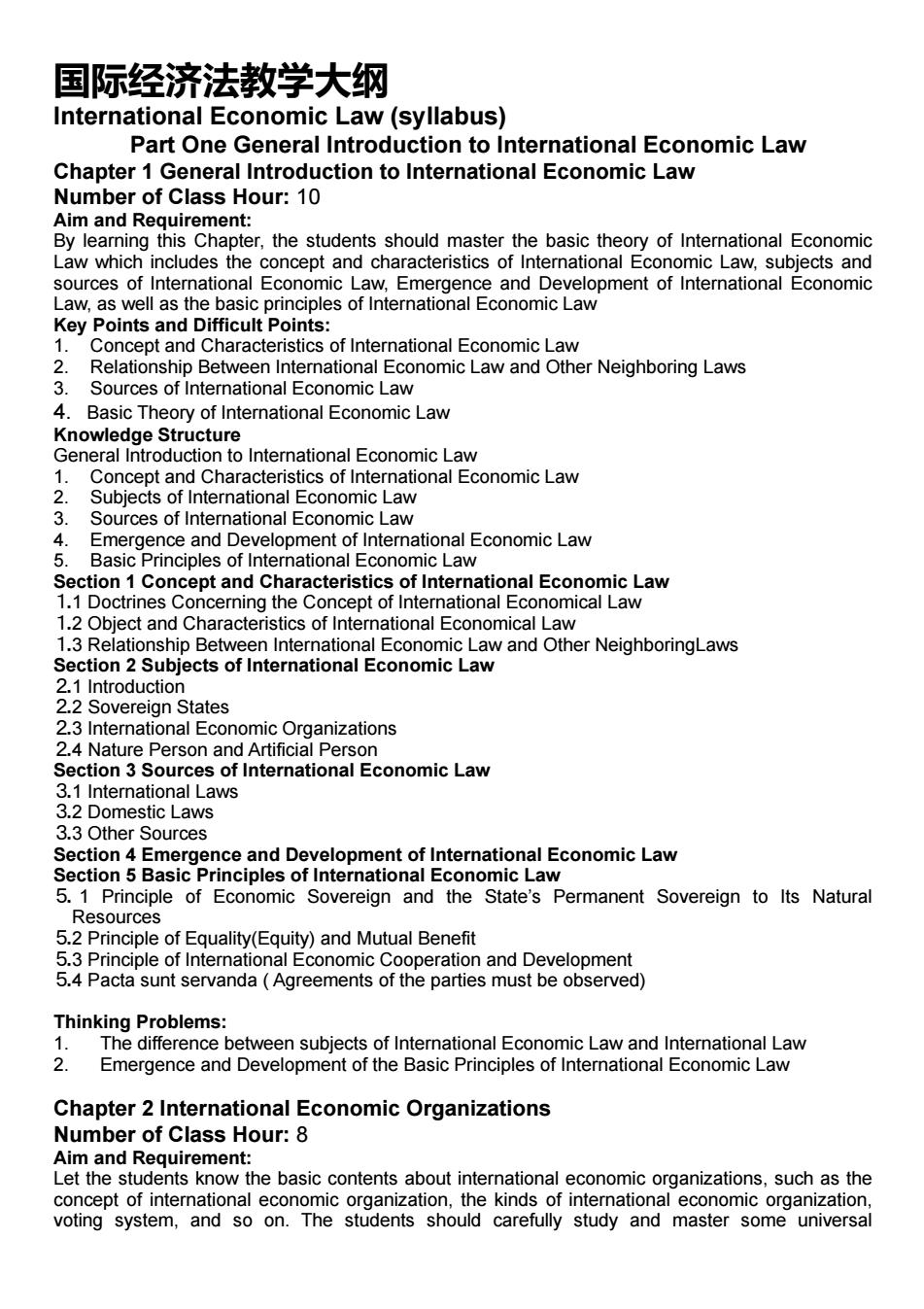
国际经济法教学大纲 International Economic Law(syllabus) Part One General Introduction to International Economic Law Chapter 1 General Introduction to International Economic Law Number of Class Hour:10 Aim and Req the students should master the basic theory of Inte ational Economic of Inte d Law,as well as the ba les of international Economic Law opment ofc L tional ects and conom Key Points and Difficult Points: Concept and Characteristics of International Economic Law 2. Relationship Between International Economic Law and Other Neighboring Laws 3. Sources of International Economic Law 4.Basic Theory of International Economic Law Knowledge Structure General Introduction to International Economic Law bjects conom 3 rces of I a ic Law Basic and al Fco al Economic Law of Int ic Law Section 1 Co acteristics of Inte national Economic Law 1.1 Doctrines Concerning the Concept of International Economical Law 1.2 Object and Characteristics of International Economical Law 1.3 Relationship Between International Economic Law and Other NeighboringLaws tion 2 Subjects of International Economic Law 44 nalEoono 839apezati ns ection 3 Sources of International Economic Law 3.1 International Laws 3.2 Domestic Laws 3.3 Other Sources Section 4 Emergence and Development of International Economic Law rinciples International Economic Law Principle of Economic Sovereign and e State's Permanent Sovereign to Its Natural R 5.2P en Thinking Problems: 2 The difference between subjects of International Economic Law and International Law Emergence and Development of the Basic Principles of International Economic Law Chapter 2 International Economic Organizations Number of Class Hour:8 Aim and Requirement: Let the students know the basic contents about international economic organizations,such as the concept of international economic organization,the kinds of international economic organization voting system,and so on.The students should carefully study and master some universal
国际经济法教学大纲 International Economic Law (syllabus) Part One General Introduction to International Economic Law Chapter 1 General Introduction to International Economic Law Number of Class Hour: 10 Aim and Requirement: By learning this Chapter, the students should master the basic theory of International Economic Law which includes the concept and characteristics of International Economic Law, subjects and sources of International Economic Law, Emergence and Development of International Economic Law, as well as the basic principles of International Economic Law Key Points and Difficult Points: 1. Concept and Characteristics of International Economic Law 2. Relationship Between International Economic Law and Other Neighboring Laws 3. Sources of International Economic Law 4. Basic Theory of International Economic Law Knowledge Structure General Introduction to International Economic Law 1. Concept and Characteristics of International Economic Law 2. Subjects of International Economic Law 3. Sources of International Economic Law 4. Emergence and Development of International Economic Law 5. Basic Principles of International Economic Law Section 1 Concept and Characteristics of International Economic Law ⒈1 Doctrines Concerning the Concept of International Economical Law ⒈2 Object and Characteristics of International Economical Law ⒈3 Relationship Between International Economic Law and Other NeighboringLaws Section 2 Subjects of International Economic Law ⒉1 Introduction ⒉2 Sovereign States ⒉3 International Economic Organizations ⒉4 Nature Person and Artificial Person Section 3 Sources of International Economic Law ⒊1 International Laws ⒊2 Domestic Laws ⒊3 Other Sources Section 4 Emergence and Development of International Economic Law Section 5 Basic Principles of International Economic Law ⒌ 1 Principle of Economic Sovereign and the State’s Permanent Sovereign to Its Natural Resources ⒌2 Principle of Equality(Equity) and Mutual Benefit ⒌3 Principle of International Economic Cooperation and Development ⒌4 Pacta sunt servanda ( Agreements of the parties must be observed) Thinking Problems: 1. The difference between subjects of International Economic Law and International Law 2. Emergence and Development of the Basic Principles of International Economic Law Chapter 2 International Economic Organizations Number of Class Hour: 8 Aim and Requirement: Let the students know the basic contents about international economic organizations, such as the concept of international economic organization, the kinds of international economic organization, voting system, and so on. The students should carefully study and master some universal

international economic organizations and regional international economic organizations which produce important effects on international economic contact. and Difficult Poi nts ys al Economic Organizations World Bank World Trade Organization 5 Furopean Union Knowledge Structure International Economic Organization Univeran introduction to International Economic Organization 123 ional Organizati Internationa Section 1 Introduction 11 Con t and characteristics of International economic Organization and law of International Economic Organization 1.2 Kinds of International Economic Organization 1.3 Membership of International Economic Organization 4Institutions(Agenci s)of nternational Economic Organization 7.6 Voting System rganizatio 2.1 Inte 2.2 World Bank Group(WBG) Section 3 World Trade Organization(WTO) 3.1 Establishment of WTO 3.2 General Introduction to WTO Basic Principles of WTO WTO 11E U International Economic Organizations 42A nton (E Fast Asian Natio (ASEAN) 4.3 Asia and Pacific Economic Cooperation Forum (APEC) 1 4 Andean Pact organization 4.5 North American Free Trade Agreement Chapter 3 Transnational Corporations Number of Class Hour:4 Aim and Requirement: Let the students know concept and characteristics of transnational corporations,as well as the egal statu us of transnational corporations.Also the students should learn something about the debt respo lity occu n parent companies and their Subsidianes and Branches ey Legal status of Transnational Corporations 3. Transnational Corporations'Debt Responsibility for Their Subsidiaries and Branches Knowledge Structure Iransnational C porations Concept and haracteristics of Transnational Corporations Legal Status orporations sponsibility for Their Subsidiaries and Branches andCharacteristics of Transnational Corporations 1.1 General Conditions of Development 1.2 Concept and Characteristics 1.3 Structure of Transnational Corporations 1.4 Confliction and Regulation
international economic organizations and regional international economic organizations which produce important effects on international economic contact. Key Points and Difficult Points: 1. Voting System of International Economic Organizations 2. International Monetary Fund 3. World Bank 4. World Trade Organization 5. European Union Knowledge Structure International Economic Organization 1. General Introduction to International Economic Organization 2. Universal International Economic Organization 3. Regional International Economic Organization Section 1 Introduction ⒈1 Concept and Characteristics of International Economic Organization and Law of International Economic Organization 1.2 Kinds of International Economic Organization 1.3 Membership of International Economic Organization ⒈4 Institutions(Agencies) of International Economic Organization ⒈5 Voting System of International Economic Organization ⒈6 Legal Personality of International Economic Organization Section 2 Global International Economic Organizations ⒉1 International Monetary Fund ( IMF) ⒉2 World Bank Group(WBG) Section 3 World Trade Organization (WTO) ⒊1 Establishment of WTO ⒊2 General Introduction to WTO ⒊3 Basic Principles of WTO ⒊4 WTO and China Section 4 Regional International Economic Organizations ⒋1 European Union (EU) ⒋2 Association of South-East Asian Nations (ASEAN) ⒋3 Asia and Pacific Economic Cooperation Forum (APEC) ⒋4 Andean Pact Organization ⒋5 North American Free Trade Agreement Chapter 3 Transnational Corporations Number of Class Hour: 4 Aim and Requirement: Let the students know concept and characteristics of transnational corporations, as well as the legal status of transnational corporations. Also the students should learn something about the debt responsibility occurred between parent companies and their Subsidiaries and Branches. Key Points and Difficult Points: 1. What’s a transnational corporation? 2. Legal Status of Transnational Corporations 3. Transnational Corporations’ Debt Responsibility for Their Subsidiaries and Branches Knowledge Structure Transnational Corporations 1. Concept and Characteristics of Transnational Corporations 2. Legal Status of Transnational Corporations 3. Transnational Corporations’ Debt Responsibility for Their Subsidiaries and Branches 4. Legal Regulations for Transnational Corporations Section 1 Concept and Characteristics of Transnational Corporations ⒈1 General Conditions of Development ⒈2 Concept and Characteristics ⒈3 Structure of Transnational Corporations ⒈4 Confliction and Regulation
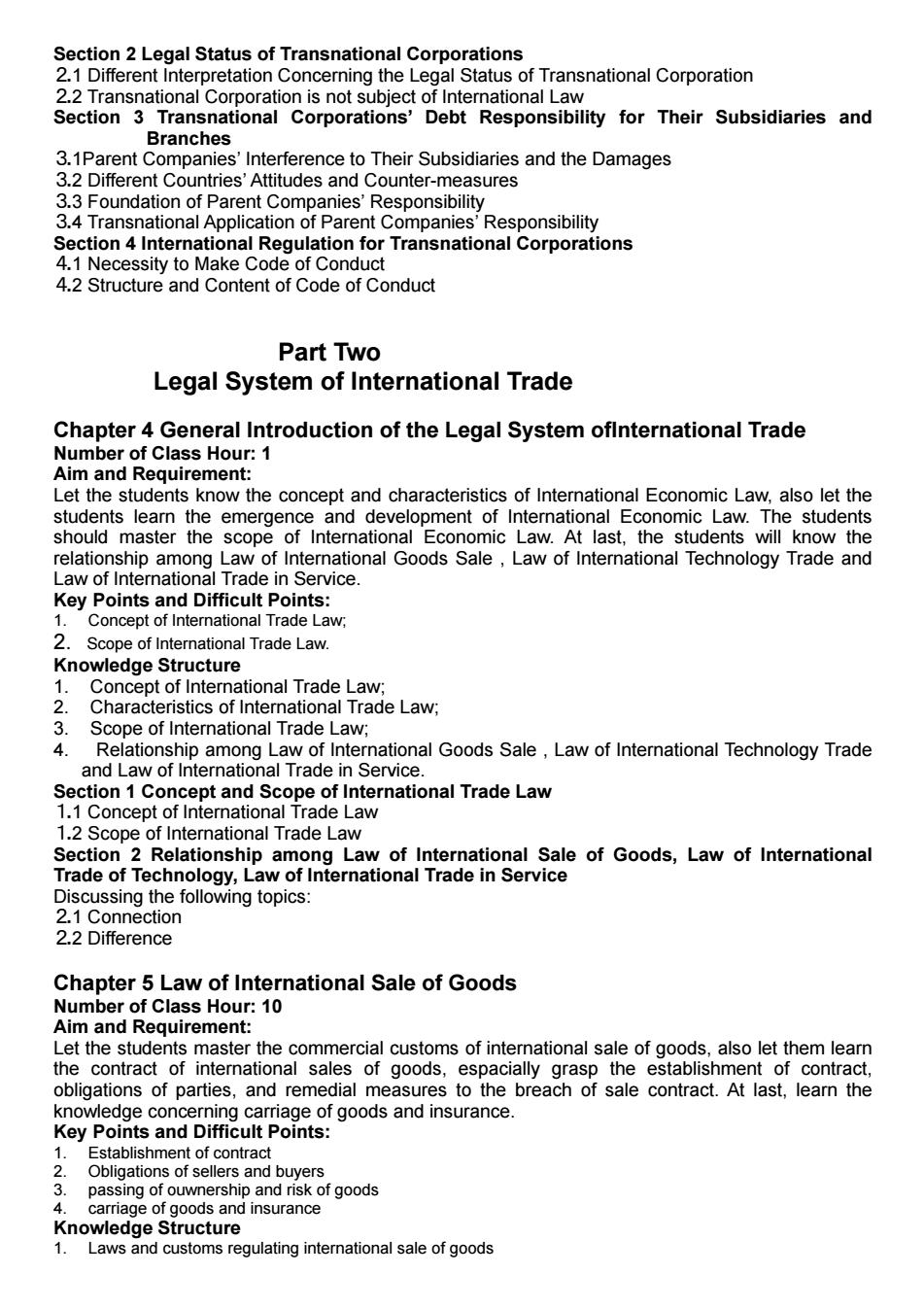
s of Transnational Corporations Different Inte s of Transnational Corporation nis no atic bt ati nsibility for Their Subsidiaries and 3.1Parent Cor panies'Interference to Their Subsidiaries and the Damages 3.2 Different Countries'Attitudes and Counter-measures 3.3 Foundation of Parent Companies'Responsibility 3.4 Transnational Application of Parent Companies'Responsibility tion for Transnational Corporations 42 sity to M 00 Structure an ontent o of Code of Conduct Part Two Legal System of International Trade Chapter 4 General Introduction of the Legal System oflnternational Trade Hour:1 stud the conce nal Economic Law. master the al Ec nsoethe national Economic Law.At last.the e student s will know the relationship among Law of International Goods Sale.Law of International Technology Trade and Law of International trade in service Key Points and Difficult Points: Concept of Intemational Trade Law 2 Scope of International Trade Law. Knowledge Structure nternational Trade Law 234 ona Trade Law; and Law of International Trade in Service national Goods Sale,Law of International Technology Trade Section 1 Concept and Sco of International Trade Law 1.1 Concept of International Trade Law 1.2 Scope of International Trade Law Section 2 Relationship among Law of International Sale of Goods,Law of International Trade of Te chnology,Law of International Trade in Service th following topics: ence Chapter 5 Law of International Sale of Goods Aim and Re 10 .10 et the students master the com mercial customs of international sale of goods,also let them learn the contract of international sales of goods,espacially grasp the establishment of contract. obligations of parties,and remedial measures to the breach of sale contract.At last,learn the knowledge concerning carriage of goods and insurance. Key Points and Difficult Points: and insurance regulating intemational sale of goods
Section 2 Legal Status of Transnational Corporations ⒉1 Different Interpretation Concerning the Legal Status of Transnational Corporation ⒉2 Transnational Corporation is not subject of International Law Section 3 Transnational Corporations’ Debt Responsibility for Their Subsidiaries and Branches ⒊1Parent Companies’ Interference to Their Subsidiaries and the Damages ⒊2 Different Countries’ Attitudes and Counter-measures ⒊3 Foundation of Parent Companies’ Responsibility ⒊4 Transnational Application of Parent Companies’ Responsibility Section 4 International Regulation for Transnational Corporations ⒋1 Necessity to Make Code of Conduct ⒋2 Structure and Content of Code of Conduct Part Two Legal System of International Trade Chapter 4 General Introduction of the Legal System ofInternational Trade Number of Class Hour: 1 Aim and Requirement: Let the students know the concept and characteristics of International Economic Law, also let the students learn the emergence and development of International Economic Law. The students should master the scope of International Economic Law. At last, the students will know the relationship among Law of International Goods Sale , Law of International Technology Trade and Law of International Trade in Service. Key Points and Difficult Points: 1. Concept of International Trade Law; 2. Scope of International Trade Law. Knowledge Structure 1. Concept of International Trade Law; 2. Characteristics of International Trade Law; 3. Scope of International Trade Law; 4. Relationship among Law of International Goods Sale , Law of International Technology Trade and Law of International Trade in Service. Section 1 Concept and Scope of International Trade Law ⒈1 Concept of International Trade Law ⒈2 Scope of International Trade Law Section 2 Relationship among Law of International Sale of Goods, Law of International Trade of Technology, Law of International Trade in Service Discussing the following topics: ⒉1 Connection ⒉2 Difference Chapter 5 Law of International Sale of Goods Number of Class Hour: 10 Aim and Requirement: Let the students master the commercial customs of international sale of goods, also let them learn the contract of international sales of goods, espacially grasp the establishment of contract, obligations of parties, and remedial measures to the breach of sale contract. At last, learn the knowledge concerning carriage of goods and insurance. Key Points and Difficult Points: 1. Establishment of contract 2. Obligations of sellers and buyers 3. passing of ouwnership and risk of goods 4. carriage of goods and insurance Knowledge Structure 1. Laws and customs regulating international sale of goods

passing of ownship and risk of goods I measures to the breach of sale contract Section 1 Laws and Customs Regulating International Sale of Goods 1.1 the Uniform Law on International Sale of Goods 13 nvention on C Rules for the Interpretation of Section 2 Establishment of contract for the International Sales of Goods 2.1Oe 2.2 Acceptance Section 3 Obligations of Buyers and Sellers 3.1 Obligations of the Seller 3.2 Obligation of the Buyer 89cgn4gai8t0pmershpandRskofGoots 4.2 Passing of Risk Section 5 Remedial Measures to the Breach of Sale Contract 5.1 Remedies for breach of contract by the seller 5.2 Remedies for breach of contract by the buyer Section6 Force Majeure and Exemption eure Section 7 International Carriage of Goods and Insurance 7.1 International Transportation of Goods 7.2 International Transportation Insurance Chapter 6 Law of International Technology Transfer(Trade) Number of Class Hour:8 Aim and Requ ement thudns le the chayrade:let na regulate intemationa Methods of International Technology Trade reaties and Agreements Gen ion to international trade lay 2.Legal Rules That Requlate International Trade Law 3 Tow Main Kinds of International Technology Trade:International License Contract and International Technology and Consultation Contract Section 1 General Introduction to International Technology Transfer 1.1 Characterist 3 e ngrTe8og9e2gnerser ogy on nal Tech onal Tech al R 2.1 UN Trar ernatio Code 2.2 TRIPS 2.3 Agreement on Technical Barriers to Trade
2. establishment of contract for the international sales of goods 3. obligations of buyers and sellers 4. passing of ownship and risk of goods 5. remedial measures to the breach of sale contract 6. force majeure and exemption 7. carriage of goods and insurance Section 1 Laws and Customs Regulating International Sale of Goods 1.1 the Uniform Law on International Sale of Goods 1.2 UN Convention on Contracts for the International Sale of Goods 1.3 International Rules for the Interpretation of Trade Terms Section 2 Establishment of contract for the International Sales of Goods 2.1 Offer 2.2 Acceptance Section 3 Obligations of Buyers and Sellers 3.1 Obligations of the Seller 3.2 Obligation of the Buyer Section 4 Passing of Ownership and Risk of Goods 4.1 Passing of Ownership 4.2 Passing of Risk Section 5 Remedial Measures to the Breach of Sale Contract 5.1 Remedies for breach of contract by the seller 5.2 Remedies for breach of contract by the buyer Section 6 Force Majeure and Exemption 6.1 Force Majeure 6.2 Exemption Section 7 International Carriage of Goods and Insurance 7.1 International Transportation of Goods 7.2 International Transportation Insurance Chapter 6 Law of International Technology Transfer (Trade) Number of Class Hour: 8 Aim and Requirement: Let the students learn the characteristics and basic methods of international technology trade; let them know some legal rules that regulate international technology trade. Key Points and Difficult Points: 1. Characteristics of International Technology Trade 2. Methods of International Technology Trade 3. Some International Treaties and Agreements Knowledge Structure 1. General Introduction to International Trade Law 2. Legal Rules That Regulate International Trade Law 3. Tow Main Kinds of International Technology Trade: International License Contract and International Technology and Consultation Contract Section 1 General Introduction to International Technology Transfer ⒈1 Characteristics of International Technology Transfer ⒈2 Main Ways of International Technology Transfer ⒈3 Concept and Characteristics of Law of International TechnologyTransfer Section 2 Legal Regulations for International Technology Transfer ⒉1 UN Transfer of Technology Code ⒉2 TRIPS ⒉3 Agreement on Technical Barriers to Trade
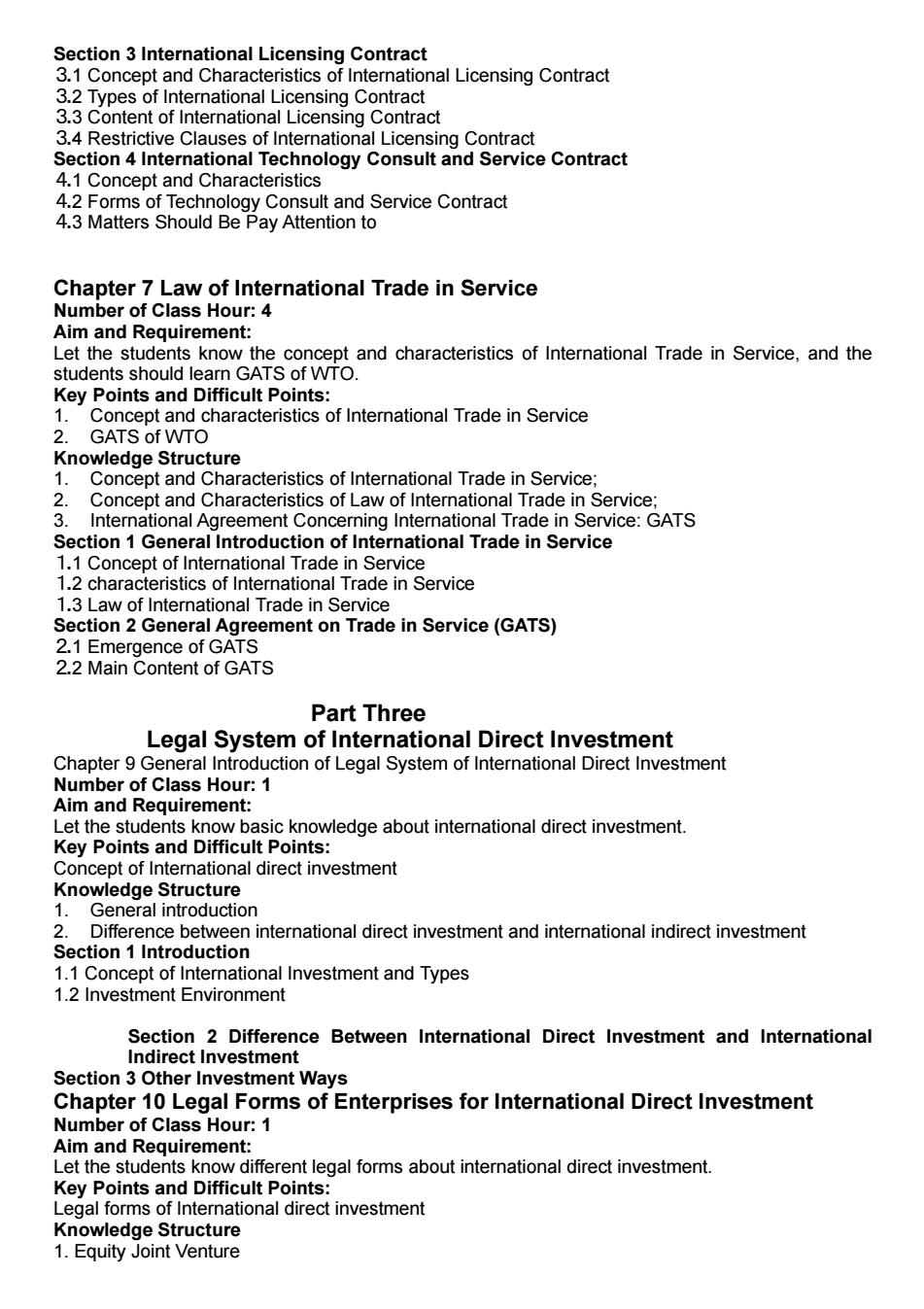
onarmonalLicening Coniract 19 t of lnt al lic al lic sina Contrac Section 4 International Technology Consult a nd Service Contract 4.1 Concept and Characteristics 4.2 Forms of Technology Consult and Service Contract 4.3 Matters Should Be Pay Attention to Chapter 7 Law of International Trade in Service Number of Class Hour:4 Aim and Requi rement Let the stude Key ant and c stics of International Trade in Service 2 GATS of WTO Knowledge Structure Concept and Characteristics of International Trade in Service; 2. Concept and Characteristics of Law of International Trade in Service; International Agreement Concerning Intermnational Trade in Service:GATS tion 1 General Introduction of Intern tional Trade in Service al Service 13 I aw of Inte ction 2 General Agreement on Trade in Service(GATS) 2.1 Emergence of GATS 2.2 Main Content of GATS Part Three Legal System of International Direct Investment Chap Intr oduction of Legal System of International Direct Investment ass Hour:1 et the tudents ko basic knowledge about international direct investment. Key Points and Difficult Points: Concept of International direct investment Knowledge Structure General introduction Difference betw on 1 interational direct investment and intemational indirect investment 1 oncept of l ntemnational Investment and Types Section 2 Difference Between International Direct Investment and International Indirect Investment Section 3 Other Investment Ways Chapter 10 Legal Forms of Enterprises for International Direct Investment Number of Class Hour:1 Aim and Requirement: Let the students know different legal forms about international direct investment. Key Points and Difficult Points: Legal forms of International direct investment dge S
Section 3 International Licensing Contract ⒊1 Concept and Characteristics of International Licensing Contract ⒊2 Types of International Licensing Contract ⒊3 Content of International Licensing Contract ⒊4 Restrictive Clauses of International Licensing Contract Section 4 International Technology Consult and Service Contract ⒋1 Concept and Characteristics ⒋2 Forms of Technology Consult and Service Contract ⒋3 Matters Should Be Pay Attention to Chapter 7 Law of International Trade in Service Number of Class Hour: 4 Aim and Requirement: Let the students know the concept and characteristics of International Trade in Service, and the students should learn GATS of WTO. Key Points and Difficult Points: 1. Concept and characteristics of International Trade in Service 2. GATS of WTO Knowledge Structure 1. Concept and Characteristics of International Trade in Service; 2. Concept and Characteristics of Law of International Trade in Service; 3. International Agreement Concerning International Trade in Service: GATS Section 1 General Introduction of International Trade in Service ⒈1 Concept of International Trade in Service ⒈2 characteristics of International Trade in Service ⒈3 Law of International Trade in Service Section 2 General Agreement on Trade in Service (GATS) ⒉1 Emergence of GATS ⒉2 Main Content of GATS Part Three Legal System of International Direct Investment Chapter 9 General Introduction of Legal System of International Direct Investment Number of Class Hour: 1 Aim and Requirement: Let the students know basic knowledge about international direct investment. Key Points and Difficult Points: Concept of International direct investment Knowledge Structure 1. General introduction 2. Difference between international direct investment and international indirect investment Section 1 Introduction 1.1 Concept of International Investment and Types 1.2 Investment Environment Section 2 Difference Between International Direct Investment and International Indirect Investment Section 3 Other Investment Ways Chapter 10 Legal Forms of Enterprises for International Direct Investment Number of Class Hour: 1 Aim and Requirement: Let the students know different legal forms about international direct investment. Key Points and Difficult Points: Legal forms of International direct investment Knowledge Structure 1. Equity Joint Venture
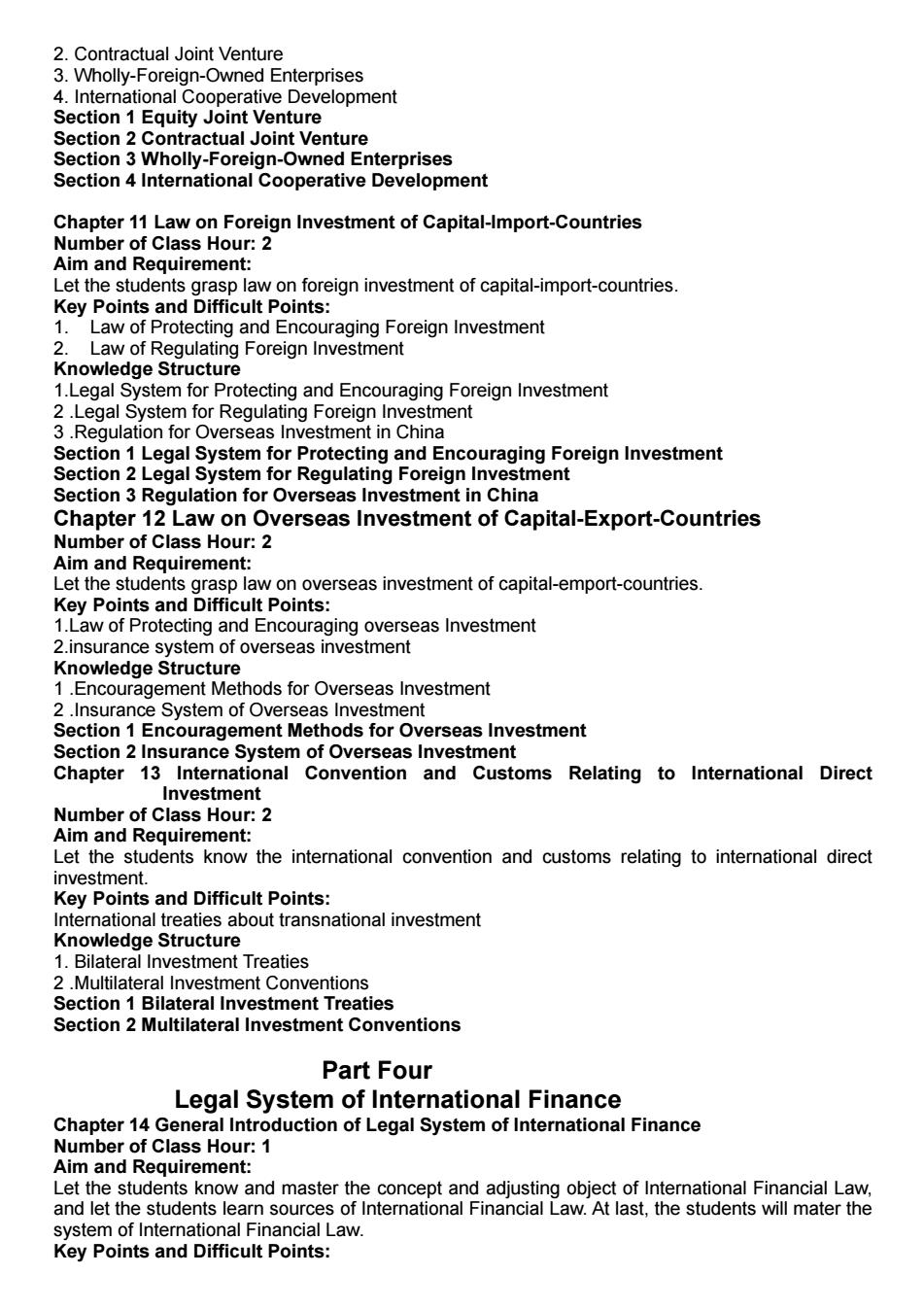
2.Contractual Joint Venture 3.Wholly-Foreign-Owned Enterprises Development quity 1 Section 3 Wholly-Foreiar en ed Enterprises Section 4 International Cooperative Development Chapter 11 Law on Foreign Investment of Capital-Import-Countries Number of Class Hour:2 Aim and Requi Key a6elgponegegninvestnentofcaptaHmpoteounties rement of De ulat Knowledge Structure Foreign 1.Legal System for Protecting and Encouraging Foreign Investment 2.Legal System for Regulating Foreign Investment 3.Regulation for Overseas Investment in China Section 1 Legal System for Prote ting and Encouraging Foreign Investment Legal Syst or Regulating Fore stment Chapter 12 Law on Overseas Investment of Capital-Export-Coun. stment in c Number of Class Hour:2 Aim and Requi remen Points sp la verseas investment of capital-emport-countries Key l aw and En urance system of overseas inv ouraging overse Investment 2 ins stment Knowledae structure 1.Encouragement Methods for Overseas Investment 2.Insurance System of Overseas Investment Section 1 Encouragement Methods for Overseas Investment surance System c T overs Chapter amet8t6 ●ustoms Relating to International Direct Number of CI Aim and reauiren Let the students know the international convention and customs relating to international direct nvestment. Key Points and Difficult Points: International treaties about transnational investment KneomledgenStcter ecmonaeal stment Treaties Section 2 Multilateral Ir tment conventions Part Four Legal System of International Finance Chapter 14 General Introduction of Legal System of International Finance Number of Class Hour:1 Aim and requirement: Let the students know and master the concept and adjusting object of International Financial Law, and let the students learn sources of International Financial Law.At last,the students will mater the system of International Financial Law. Key Points and Difficult Points:
2. Contractual Joint Venture 3. Wholly-Foreign-Owned Enterprises 4. International Cooperative Development Section 1 Equity Joint Venture Section 2 Contractual Joint Venture Section 3 Wholly-Foreign-Owned Enterprises Section 4 International Cooperative Development Chapter 11 Law on Foreign Investment of Capital-Import-Countries Number of Class Hour: 2 Aim and Requirement: Let the students grasp law on foreign investment of capital-import-countries. Key Points and Difficult Points: 1. Law of Protecting and Encouraging Foreign Investment 2. Law of Regulating Foreign Investment Knowledge Structure 1.Legal System for Protecting and Encouraging Foreign Investment 2 .Legal System for Regulating Foreign Investment 3 .Regulation for Overseas Investment in China Section 1 Legal System for Protecting and Encouraging Foreign Investment Section 2 Legal System for Regulating Foreign Investment Section 3 Regulation for Overseas Investment in China Chapter 12 Law on Overseas Investment of Capital-Export-Countries Number of Class Hour: 2 Aim and Requirement: Let the students grasp law on overseas investment of capital-emport-countries. Key Points and Difficult Points: 1.Law of Protecting and Encouraging overseas Investment 2.insurance system of overseas investment Knowledge Structure 1 .Encouragement Methods for Overseas Investment 2 .Insurance System of Overseas Investment Section 1 Encouragement Methods for Overseas Investment Section 2 Insurance System of Overseas Investment Chapter 13 International Convention and Customs Relating to International Direct Investment Number of Class Hour: 2 Aim and Requirement: Let the students know the international convention and customs relating to international direct investment. Key Points and Difficult Points: International treaties about transnational investment Knowledge Structure 1. Bilateral Investment Treaties 2 .Multilateral Investment Conventions Section 1 Bilateral Investment Treaties Section 2 Multilateral Investment Conventions Part Four Legal System of International Finance Chapter 14 General Introduction of Legal System of International Finance Number of Class Hour: 1 Aim and Requirement: Let the students know and master the concept and adjusting object of International Financial Law, and let the students learn sources of International Financial Law. At last, the students will mater the system of International Financial Law. Key Points and Difficult Points:
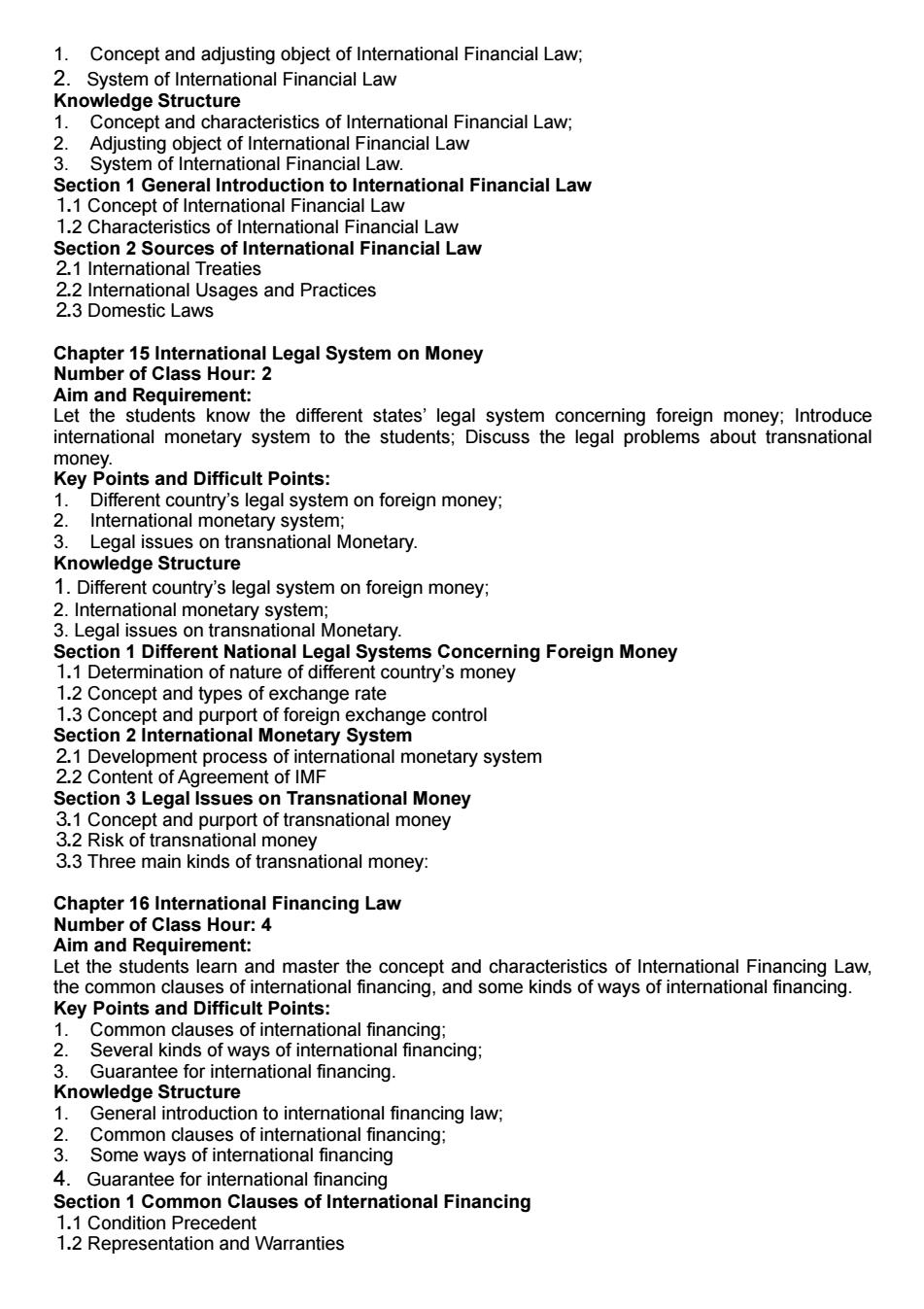
Concept and adjusting object of International Financial Law: 2.System of International Financial Law Knowledge Structure Concept and characteristics of International Financial Law: ational Financial Law 1.1Cg to Int 12 Characteristics of Internatic al Financial Law Section 2 Sources of International Financial Law 2 1 International treaties 2.2 International Usages and Practices 2.3 Domestic Laws Chapter 15I on Money ss Hour: Let the udents know the different states'legal system concerning foreign money:Introduce intemational monetary system to the students;Discuss the legal problems about transnational Key Points and Difficult Points: Different country's legal system on foreign money: 2 International monetary system e n transnational Monetary. wledge Structure Different country's legal system on foreign money; 2.system Lega es or nal tary 1.1 Dete Legal Syst ems Concerning Foreign Money 12concept and types of exchange ntrys mone rate I 3 Concent and r t of foreign exchange control Section 2 international Monetary System 2.1 Development process of international monetary system 2.2 Content of Agreement of IMF 3 ction 3 Legal Issues on Transnational Money money 3.3T of transnational money: Chapter 16 International Financing Law Number of Class Hour:4 Aim and Requirement: Let the students learn and master the concept and characteristics of International Financing Law, the common claus of international financing,and some kinds of ways of international financing. Key Points and Difficult F f int vera ds of financing: Knowledge Structure General introduction to international financing law 2 Common clauses of international financing: 3. Some ways of international financing 4. Guarantee for international financing Section 1 Common Clauses of International Financing 1.1 Condition Precedent 1.2 Representation and Warranties
1. Concept and adjusting object of International Financial Law; 2. System of International Financial Law Knowledge Structure 1. Concept and characteristics of International Financial Law; 2. Adjusting object of International Financial Law 3. System of International Financial Law. Section 1 General Introduction to International Financial Law ⒈1 Concept of International Financial Law ⒈2 Characteristics of International Financial Law Section 2 Sources of International Financial Law ⒉1 International Treaties ⒉2 International Usages and Practices ⒉3 Domestic Laws Chapter 15 International Legal System on Money Number of Class Hour: 2 Aim and Requirement: Let the students know the different states’ legal system concerning foreign money; Introduce international monetary system to the students; Discuss the legal problems about transnational money. Key Points and Difficult Points: 1. Different country’s legal system on foreign money; 2. International monetary system; 3. Legal issues on transnational Monetary. Knowledge Structure 1. Different country’s legal system on foreign money; 2. International monetary system; 3. Legal issues on transnational Monetary. Section 1 Different National Legal Systems Concerning Foreign Money ⒈1 Determination of nature of different country’s money ⒈2 Concept and types of exchange rate ⒈3 Concept and purport of foreign exchange control Section 2 International Monetary System ⒉1 Development process of international monetary system ⒉2 Content of Agreement of IMF Section 3 Legal Issues on Transnational Money ⒊1 Concept and purport of transnational money ⒊2 Risk of transnational money ⒊3 Three main kinds of transnational money: Chapter 16 International Financing Law Number of Class Hour: 4 Aim and Requirement: Let the students learn and master the concept and characteristics of International Financing Law, the common clauses of international financing, and some kinds of ways of international financing. Key Points and Difficult Points: 1. Common clauses of international financing; 2. Several kinds of ways of international financing; 3. Guarantee for international financing. Knowledge Structure 1. General introduction to international financing law; 2. Common clauses of international financing; 3. Some ways of international financing 4. Guarantee for international financing Section 1 Common Clauses of International Financing ⒈1 Condition Precedent ⒈2 Representation and Warranties
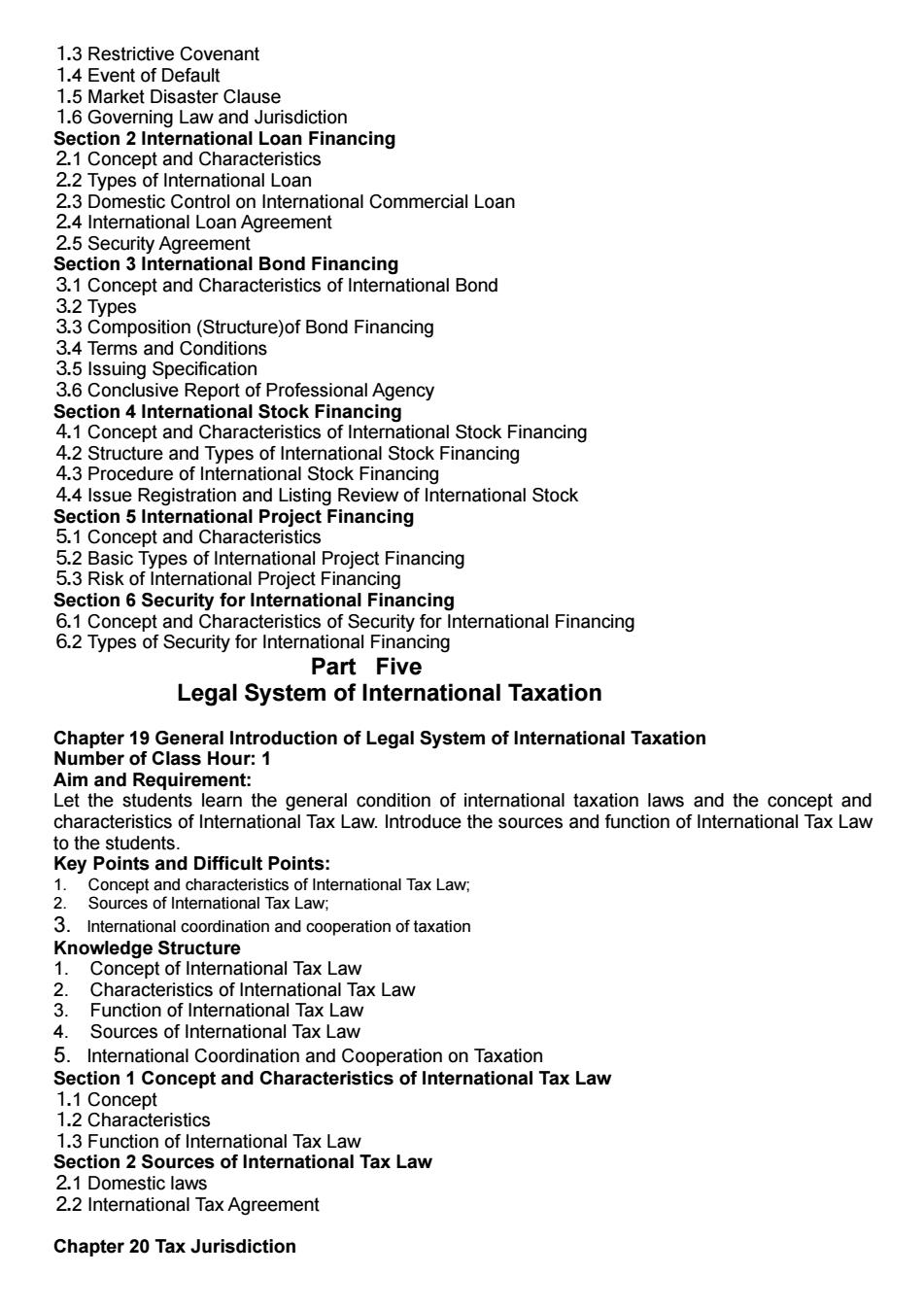
1.3 Restrictive Covenant L ster a isdictio 21 Concept an ncing 2.2 Types of International loan 2.3 Domestic Control on International Commercial Loan 2.4 International Loan Agreement 2.5 Security Agreement tion 3 International Bond Fin ancing Types (Structure)of Bond Financing 3.4 Tem and co 3.5 Issuing Specification 3.6 Conclusive Report of Professional Agency Section 4 International Stock Financing 4.1 Concept and Characteristics of International Stock Financing 4.2 Structure and Types of Inte ernational Stock Financing Proc re c AA k Financing ing F eview of International Stock 5.1 Concep 5.2 Basic T s of Inter tional Project Financing 5.3 Risk of International Project Financing Section 6 Security for International Financing 6.1 Concept and Characteristics of Security for International Financing 6.2 Types of Secunity for International Financing Part Five Legal System of International Taxation Aim and Requirement Let the students learn the general condition of international taxation laws and the concept and characteristics of International Tax Law.Introduce the sources and function of International Tax Law to the students. Key Points and Difficult Points: Tax Law. rdin atio n and c oope ration of taxation Kno ledge Str Con ept of International Tax Law 2 Characteristics of International Tax Law 3. Function of International tax law 4. Sources of International Tax Law 5. International Coordination and Cooperation on Taxation Section 1 Concept and Characteristics of International Tax Law 1.1 Concept 1.2 Characteristics 1.3 Function of International Tax Law ion 2 Sor rces of International Tax Law I Tax Agreement Chapter 20 Tax Jurisdiction
⒈3 Restrictive Covenant ⒈4 Event of Default ⒈5 Market Disaster Clause ⒈6 Governing Law and Jurisdiction Section 2 International Loan Financing ⒉1 Concept and Characteristics ⒉2 Types of International Loan ⒉3 Domestic Control on International Commercial Loan ⒉4 International Loan Agreement ⒉5 Security Agreement Section 3 International Bond Financing ⒊1 Concept and Characteristics of International Bond ⒊2 Types ⒊3 Composition (Structure)of Bond Financing ⒊4 Terms and Conditions ⒊5 Issuing Specification ⒊6 Conclusive Report of Professional Agency Section 4 International Stock Financing ⒋1 Concept and Characteristics of International Stock Financing ⒋2 Structure and Types of International Stock Financing ⒋3 Procedure of International Stock Financing ⒋4 Issue Registration and Listing Review of International Stock Section 5 International Project Financing ⒌1 Concept and Characteristics ⒌2 Basic Types of International Project Financing ⒌3 Risk of International Project Financing Section 6 Security for International Financing ⒍1 Concept and Characteristics of Security for International Financing ⒍2 Types of Security for International Financing Part Five Legal System of International Taxation Chapter 19 General Introduction of Legal System of International Taxation Number of Class Hour: 1 Aim and Requirement: Let the students learn the general condition of international taxation laws and the concept and characteristics of International Tax Law. Introduce the sources and function of International Tax Law to the students. Key Points and Difficult Points: 1. Concept and characteristics of International Tax Law; 2. Sources of International Tax Law; 3. International coordination and cooperation of taxation Knowledge Structure 1. Concept of International Tax Law 2. Characteristics of International Tax Law 3. Function of International Tax Law 4. Sources of International Tax Law 5. International Coordination and Cooperation on Taxation Section 1 Concept and Characteristics of International Tax Law ⒈1 Concept ⒈2 Characteristics ⒈3 Function of International Tax Law Section 2 Sources of International Tax Law ⒉1 Domestic laws ⒉2 International Tax Agreement Chapter 20 Tax Jurisdiction
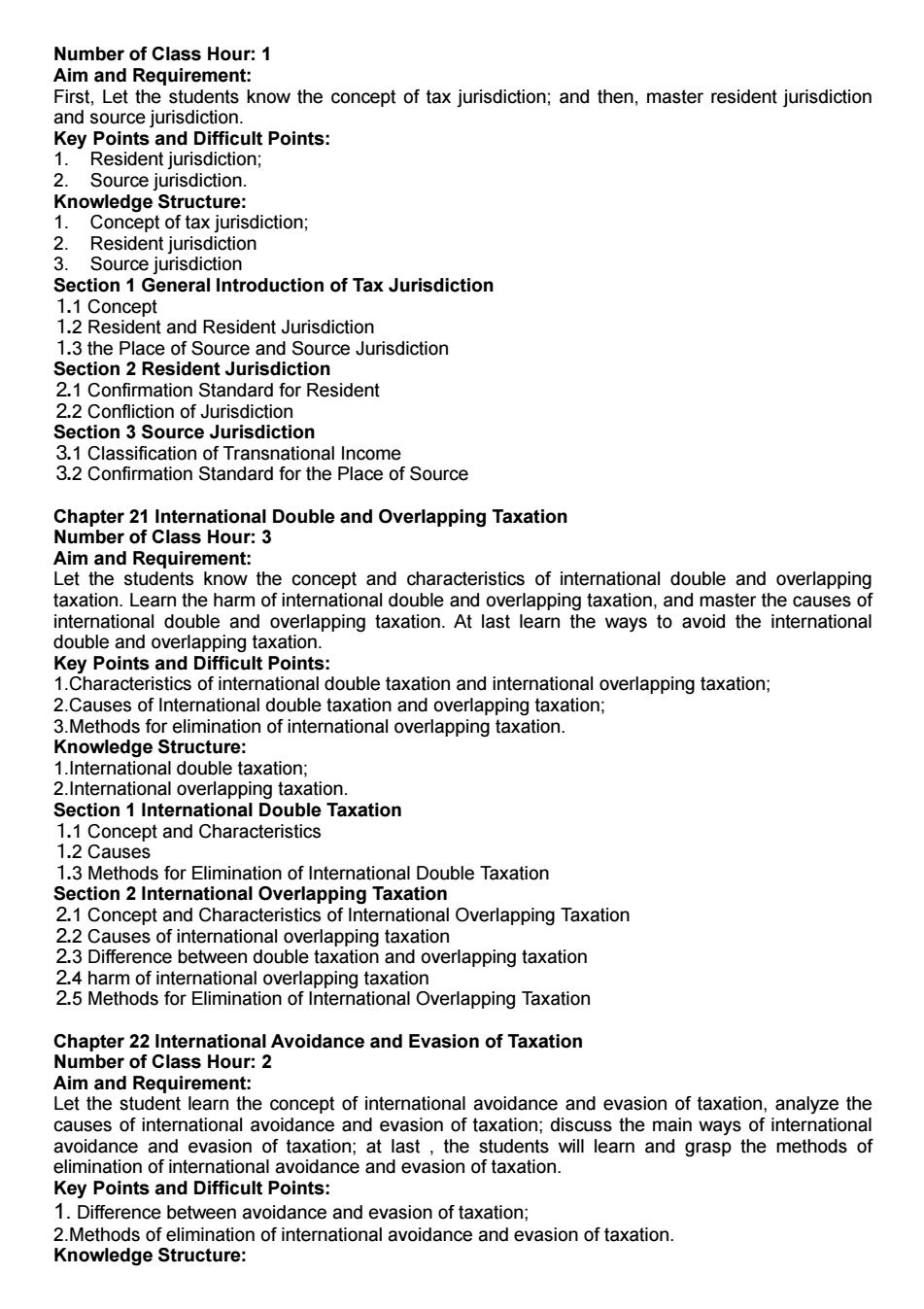
Number of Class Hour:1 Aim and Re s know the concept of tax jurisdiction;and then,master resident jurisdiction peints and Diff ult Points Resident iur liction 2 Source iurisdiction Knowledge Structure: Concept of tax jurisdiction; 2 Resident ju General Introduction of Tax Jurisdiction 11 and Resident Jurisdiction 1.3 the Place of Source and Source Jurisdiction Section 2 Resident Jurisdiction 2.1 Confirmation Standard for Resident 2.2 Confliction of Jurisdiction ction 3 Source Jurisdiction baer2nesaoaagDoubleand0oveiapingTaxaion Aim and Requirement: Let the students know the concept and characteristics of international double and overlapping taxation.Learn the harm of international double and overlapping taxation,and master the causes of international double and overlapping taxation.At last learn the ways to avoid the international 2.Car ule tavertap ati Knowledge Structure: 1.International double taxation; 2.International overlapping taxation. ction 1 International Double Taxation 1.1 Concept and Characteristics 3 ds for Eli m n o ernat nal Double Taxation n 2 Int 2.1 Concept and Characteristic Overlapping Taxation 2.2 Causes of international overlap na taxation 2.3 Difference between double taxation and overlapping taxation 2.4 harm of intemational overlapping taxation 2.5 Methods for Elimination of International Overlapping Taxation IAvoidance and Evasion of Taxation ss Hour:2 Let the ent learn the concept of international avoidance and evasion of taxation analyze the es of intemnational avoidance and evasion of taxation:discuss the main ways of international avoidance and evasion of taxation;at last,the students will learn and grasp the methods of elimination of international avoidance and evasion of taxation. Key Points and Difficult Points: 1.Difference between avoidance and evasion of taxation; 2.Methods of elimination of international avoidance and evasion of taxation. Knowledge Structure:
Number of Class Hour: 1 Aim and Requirement: First, Let the students know the concept of tax jurisdiction; and then, master resident jurisdiction and source jurisdiction. Key Points and Difficult Points: 1. Resident jurisdiction; 2. Source jurisdiction. Knowledge Structure: 1. Concept of tax jurisdiction; 2. Resident jurisdiction 3. Source jurisdiction Section 1 General Introduction of Tax Jurisdiction ⒈1 Concept ⒈2 Resident and Resident Jurisdiction ⒈3 the Place of Source and Source Jurisdiction Section 2 Resident Jurisdiction ⒉1 Confirmation Standard for Resident ⒉2 Confliction of Jurisdiction Section 3 Source Jurisdiction ⒊1 Classification of Transnational Income ⒊2 Confirmation Standard for the Place of Source Chapter 21 International Double and Overlapping Taxation Number of Class Hour: 3 Aim and Requirement: Let the students know the concept and characteristics of international double and overlapping taxation. Learn the harm of international double and overlapping taxation, and master the causes of international double and overlapping taxation. At last learn the ways to avoid the international double and overlapping taxation. Key Points and Difficult Points: 1.Characteristics of international double taxation and international overlapping taxation; 2.Causes of International double taxation and overlapping taxation; 3.Methods for elimination of international overlapping taxation. Knowledge Structure: 1.International double taxation; 2.International overlapping taxation. Section 1 International Double Taxation ⒈1 Concept and Characteristics ⒈2 Causes ⒈3 Methods for Elimination of International Double Taxation Section 2 International Overlapping Taxation ⒉1 Concept and Characteristics of International Overlapping Taxation ⒉2 Causes of international overlapping taxation ⒉3 Difference between double taxation and overlapping taxation ⒉4 harm of international overlapping taxation ⒉5 Methods for Elimination of International Overlapping Taxation Chapter 22 International Avoidance and Evasion of Taxation Number of Class Hour: 2 Aim and Requirement: Let the student learn the concept of international avoidance and evasion of taxation, analyze the causes of international avoidance and evasion of taxation; discuss the main ways of international avoidance and evasion of taxation; at last , the students will learn and grasp the methods of elimination of international avoidance and evasion of taxation. Key Points and Difficult Points: 1. Difference between avoidance and evasion of taxation; 2.Methods of elimination of international avoidance and evasion of taxation. Knowledge Structure:

1.Concept of international avoidance and evasion of taxation; 2 Methods of international avoidance and evasion of taxation 3 Countermeasures of international avoidance and evasion of taxation Section 1 General Introduction 1.1 Concept of International Avoidance and Evasion of Taxation .3 Harm o International Avoidance and Evasion of Taxation idance ar vasion 2.1M83 ce an d on asion of Taxation i y national Avoidance International S ection 3 Cou easures of International Avoidance and Evasion of Taxation 3.1 General Countermeasures of Domestic Laws 3.2 Special Countermeasures of Domestic Laws 3.3 Countermeasures of International Laws Chapter 23 Gng mber of class hour:1 Aim and Reg Let the students learn the main ways to settle the disputes in international transactions and economic relations Key Points and Difficult Points: 1.Civil action concerning foreian interests 2.International Commercial Arbitration; 3.WTO disputes settlement mechanism. Knowledge Structure: 1.General introduction to the international economic disputes settlement; 2.Main ways of settlement 3.WTO disputes settlement mechanism ction 1 Consultation,Conciliation(Mediation)and Action ction ci cerning foreign inte sts) 21 Concept acteristics and Kinds of Arbitration 2.2 Arbitrai Ag nent 2.3 Rules of Governing Law of Arbitration 2.4 Recognition and Enforcement(Execution)of Foreign Arbitral Awards w York Convention Chapter 24 ternation nt Arbitration Institutions and Their Rule ited Nati h21 n on m a 50 2 Ar ommerc Chapter 25 Reai an t Arbitration Institutions outes (ICSID) mited) Section 1 Fore nStates'Arbitration Institution s and the Rules Section 2 China's Arbitration Institutions and the Rules
1.Concept of international avoidance and evasion of taxation; 2.Methods of international avoidance and evasion of taxation; 3.Countermeasures of international avoidance and evasion of taxation Section 1 General Introduction ⒈1 Concept of International Avoidance and Evasion of Taxation ⒈2 Causes of International Avoidance and Evasion of Taxation ⒈3 Harm of International Avoidance and Evasion of Taxation Section 2 Basic Ways of International Avoidance and Evasion of Taxation ⒉1 Main ways of International Evasion of Taxation ⒉2 Main ways of International Avoidance International Section 3 Countermeasures of International Avoidance and Evasion of Taxation ⒊1 General Countermeasures of Domestic Laws ⒊2 Special Countermeasures of Domestic Laws ⒊3 Countermeasures of International Laws Part Six Legal System of the International Economic Dispute Settlement Chapter 23 General Introduction Number of class hour: 1 Aim and Requirement: Let the students learn the main ways to settle the disputes in international transactions and economic relations. Key Points and Difficult Points: 1.Civil action concerning foreign interests; 2.International Commercial Arbitration; 3.WTO disputes settlement mechanism. Knowledge Structure: 1.General introduction to the international economic disputes settlement; 2.Main ways of settlement 3.WTO disputes settlement mechanism Section 1 Consultation, Conciliation ( Mediation) and Action ⒈1 Consultation ⒈2 Conciliation ⒈3 Action (civil action concerning foreign interests) Section 2 International Commercial Arbitration ⒉1 Concept ,Characteristics and Kinds of Arbitration ⒉2 Arbitral Agreement ⒉3 Rules of Governing Law of Arbitration ⒉4 Recognition and Enforcement(Execution) of Foreign Arbitral Awards New York Convention Chapter 24 International Permanent Arbitration Institutions and Their Rules(ommited) Section 1 Arbitration Rules of United Nations Commission on International Trade Law (UNCITRAL) Section 2 Arbitration Rules of International Chamber of Commerce (ICC) Section 3 Arbitration Rules of International Center for Settlement of Investment Disputes (ICSID) Chapter 25 Regional Permanent Arbitration Institutions and Their Rules(ommited) Section 1 Foreign States’ Arbitration Institutions and the Rules Section 2 China’s Arbitration Institutions and the Rules